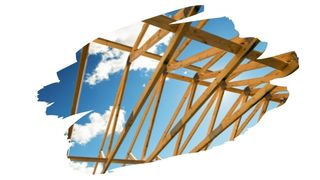A well constructed building first starts with a well constructed frame. So, that framework of joists and studs all needs to be made from a material that is stable.
That lumber must also be strong enough to support the weight of that structure. And yet it must also be flexible enough to allow for changes in temperature and humidity.
So, what makes whitewood suitable for this job?
Well, in this post, we explain the difference between the whitewood sold in home improvement stores, and actual whitewood lumber.
You will also learn what you need to look for when it comes to choosing the best timber for framing. And keep reading to find out if whitewood fits the bill…

This post may contain affiliate links to products that we receive a commission for (at no additional cost to you). Learn more here.
What’s The Best Type Of Wood For Framing?
Framing wood needs to be strong, and have few defects or knots. It also needs to be stable, meaning it won’t warp and twist out of position if it gets a little rain on it.
However, it needs to also be a little bit flexible too, to allow for a bit of give in the overall structure.
Now, wood types with fairly straight grain, allow for this flexibility. That’s why Spruce, Douglas Fir, and even Pine wood, are the most widely used types of timber for framing.
Douglas fir in particular is a very stable softwood. After it’s been seasoned, Douglas Fir will barely shift around ever again.
So, if you need a dimensionally stable wood that isn’t going to throw your measurements off on a particularly humid day, then Douglas Fir is ideal.
Related Post: What Is The Best Treatment For Douglas Fir Porch Decking?
What About Whitewood? What Is Whitewood Exactly?
Well, there tends to be a bit of a misconception about this particular lumber.
You see, whitewood is a specific type of wood. However, it is also a catch-all nickname for a number of different types of pale lumber.
Whitewood is Tulipwood
Officially, whitewood comes from the American tulip tree. Also referred to as Yellow Poplar or Tulipwood, this hardwood grows right across North America.
This particular timber is often used to craft instruments, cabinetry and interior furniture items. And it is only a touch softer than Douglas Fir, with a Janka rating of 540 lbf.
Related Post: Here’s Why Sealing Poplar For Outdoor Use Doesn’t Really Work
And What Is A Janka Rating?
When we want to measure how hard a piece of wood is, we measure its compressional strength using a scale called the Janka Hardness Scale.
This scale measures how much force, (measure in pounds of force ‘lbf), it takes to crack the surface of wood. The higher the Janka rating, the more pounds of force it takes to smash through that lumber.
Whitewood has a Janka rating of 540 lbf. Which means that it takes 540 pounds of force to crack it.
Douglas Fir, on the other hand, has a Janka rating of 660 lbf. So, it will take 660 pounds of force to make a meaningful dent in this softwood.
And Is Tulip Tree Whitewood Good For The Outdoors? Is It Rot Resistant?
Whitewood from the Tulip tree is not resistant to decay, and it can be scratched fairly easily.
So, it is not a suitable choice lumber for outdoor construction.
Related Post: Is Whitewood Really Any Good For Framing?
And What Kind Of Whitewood Is On Sale At My Local Home Improvement Store?
OK, here’s where the confusion comes in. Your local home improvement store likely uses the title ‘whitewood’ to refer to their general range of timber.
Whether it be Pine, Douglas Fir, or Spruce, they all can end up falling under the general nickname of Whitewood when it comes to ticket sales. And, as we mentioned earlier, these three types of wood are great for framing.
So, if you are buying ‘whitewood’ from your local home improvement store, then it is likely more than suitable for framing structures.
Otherwise, genuine Whitewood (aka Tulipwood) is not.
To Wrap Up, Here Are The 3 Key Takeaways From This Post…
- 1). Genuine Whitewood comes from the Tulip Tree. Also known as Yellow Poplar or Tulipwood, this hardwood grows abundantly in North America.
- 2). In home improvement stores, Whitewood is also the catch-all nickname given to various types of framing wood, such as Douglas Fir and Pine.
- 3). Whitewood (Tulipwood) is not suitable for framing. However, home store whitewood, (such as Douglas Fir, Spruce, and Pine), is ideal for framing structures.

